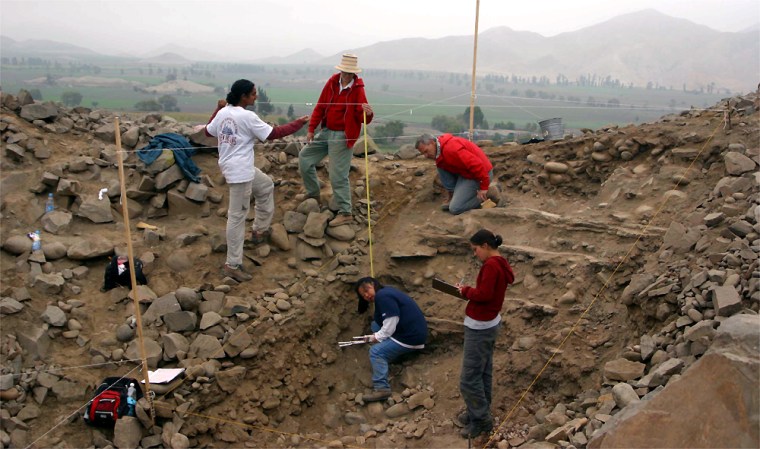Three river valleys that cross the windblown desert of coastal Peru were once home to the earliest urban society yet found in the Americas, a set of cities with ceremonial complexes — complete with pyramids — far more extensive than the first excavations suggested, archaeologists reported yesterday.
Researchers said recently completed radiocarbon tests at 13 large sites in Peru's Norte Chico region showed that the cities were occupied for 1,200 years by relatively sophisticated communities beginning around 3000 B.C., making the civilization as old as ancient Egypt's. The inhabitants probably grew cotton commercially and traded it to coastal communities for fish, the researchers said.
"There's nothing [contemporary] of this magnitude in the Americas," said archaeologist Jonathan Haas of Chicago's Field Museum. "It's the center of a hierarchical pattern — you have all the big sites concentrated in one zone, while everything else in the landscape is little."
Haas's team, reporting today in the journal Nature, described a 700-square-mile area of coastal desert embracing the Supe, Pativilca and Fortaleza river valleys 70 to 95 miles north of the modern Peruvian capital of Lima.
The region has interested archaeologists for decades because the cold ocean waters of the Humboldt Current make it one of the richest fishing areas of the world — a resource exploited by local inhabitants since the Stone Age.
Researchers years ago identified a substantial prehistoric settlement along the coast, but the recent work in Norte Chico has focused on a larger number of inland mounds flanking the rivers emptying out of the Andes Mountains.
For several years, Haas's team has excavated a site with six pyramids near the Norte Chico town of Caral. Haas said he and colleagues Winifred Creamer and Alvaro Ruiz of Northern Illinois University have identified 20 large sites, each with at least one terraced pyramid and some with as many as seven.
"Anybody driving up the valleys is going to see them, but recognizing them as archaeological sites is challenging," Haas said. "Many of the local people see them simply as hills." All together, he said, the sites could have supported more than 20,000 inhabitants.
Haas said his team obtained radiocarbon dating of material gathered from garbage heaps and pyramids at 13 of the 20 sites.
The tests showed that the sites were inhabited between 3200 B.C. and 1800 B.C. and reflected the same unusual mix of primitive technology and sophisticated social organization noted several years ago during the Caral excavation.
"There are no ceramics, limited textiles, no metal and only the most primitive stone tools," Haas said. The evidence to date at Norte Chico suggests that the contemporaneous societies in Egypt and Mesopotamia were far more technologically advanced.
Nevertheless, Haas said, the Norte Chico inhabitants were building pyramids as high as 60 feet on rectangular bases as long as 300 feet and as wide as 240 feet. Each center had a ceremonial circular plaza surrounded by stone pillars 6 to 12 feet tall.
"The technology isn't much, but the sites are substantial in size, and size counts," said archaeologist Brian S. Bauer of the University of Illinois at Chicago. "Size represents the amount of labor that can be organized, and given that people don't offer their labor freely, it reflects a social hierarchy or a concentration of power."
Haas said many of the Norte Chico pyramids began as buildings with rooms inside that were subsequently "entombed" within stone walls faced with white, pink, yellow or light-blue plaster.
Masons used reed bags full of stones to fill out each level of the pyramid. Then they built a new structure on top, adding facing and stones to create a progression of terraces similar to those used much later by the Maya of Central America.
The garbage heaps yielded huge numbers of anchovy and sardine bones as well as shellfish remains, but no bones of land animals or of the immense predatory fish that prowl the Humboldt Current.
All of these findings supported the early theory that the inland Norte Chico communities probably grew cotton and traded it for fish to coastal fishermen, who used the cotton to make nets. Bluefin tuna and other large Humboldt fish must be caught with hook and line in deep water off the coast.
Haas also noted that every site lies adjacent to an irrigation canal, and that the garbage heaps contained "all kinds of organics." They include cotton fiber and residue of beans, chilis, avocados, guavas, squash, a podded tree fruit known today as pacay, and a stone fruit called lucuma.
"They have agriculture, and you never have to pull the [irrigation] water more than a kilometer," Haas said. "The reason we get the [population] explosion is because agriculture is easy here."
Bauer, however, said the absence of a staple food crop — usually corn or potatoes in Andean countries — suggested that the Norte Chico inhabitants were growing "industrial cotton" on a relatively large scale and maybe nothing else.
"In Mesopotamia, Egypt and China, you tend to think of cereal production — rice or wheat," Bauer said. "That comes later in Peru."
In Norte Chico, by contrast, "these people concentrated on the seashore. The Peruvian coast has one of the highest fish densities in the world."
